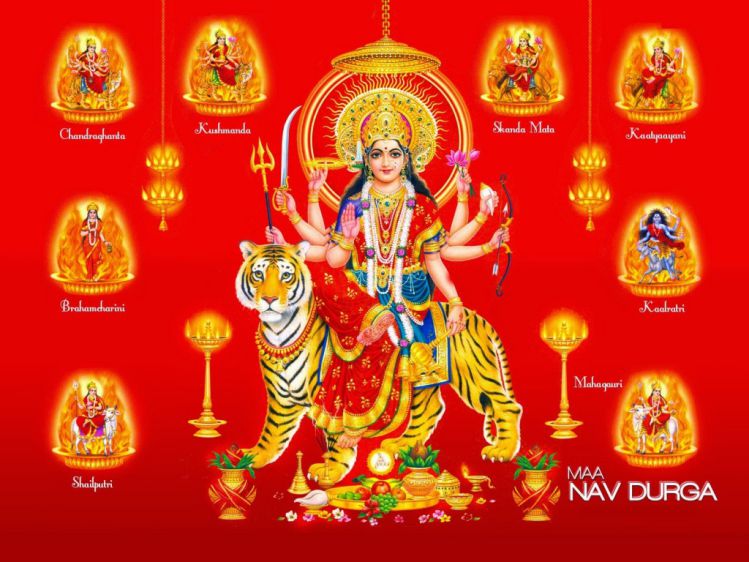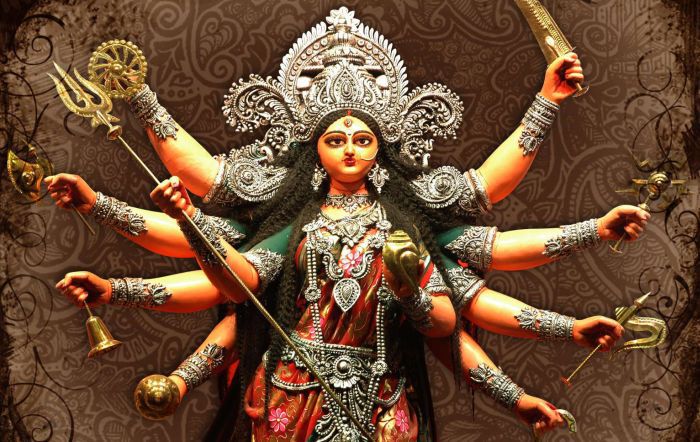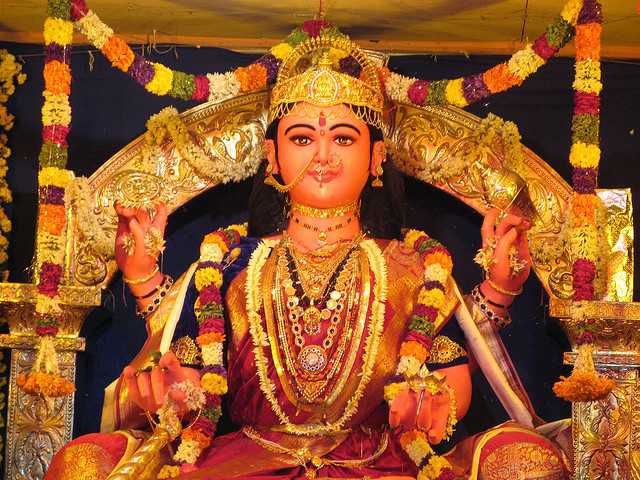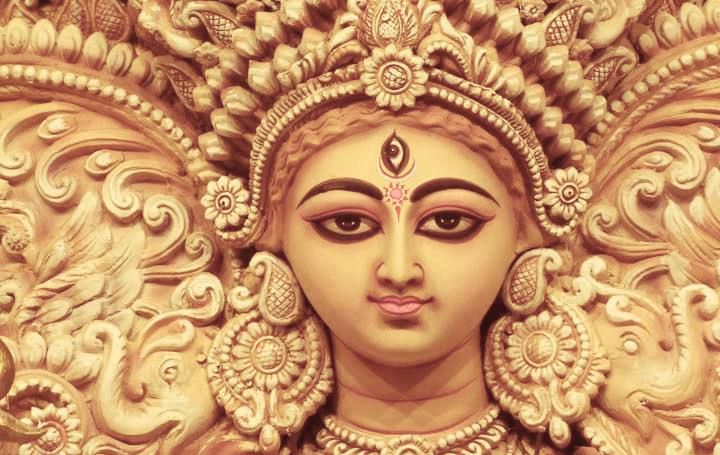No products in the cart.
Believed as the root cause of creation, sustenance and annihilation, Durga is the principal form of the Mother Goddess in Hinduism. The name ‘Durga’ in Sanskrit means ‘invincible’. The syllable ‘du’ is synonymous with the 4 devils namely poverty, sufferings, famine and evil habits. The ‘r’ refers to diseases and the ‘ga’ is the destroyer of sins, injustice, irreligion, cruelty and laziness.
The Hindu Goddess Durga is a unified symbol of all divine forces and is said to have manifested when evil forces threatened the very existence of the Gods. To destroy these demons, all Gods offered their radiance to her creation and each formed different parts of Durga’s body. She also obtained very powerful weapons, such as the Chakra from Vishnu and the Trishul (trident) from Lord Shiva.
Goddess Durga, hence, rose to power and killed the powerful demon Mahish and all his great commanders.
Shardiya Navaratri is the most popular and significant Navaratri of all Navaratris. That’s why Shardiya Navaratri is also known as Maha Navaratri. It falls in lunar month of Ashwin or Kartik (September-October) during Sharad Ritu and hence derives the name.
Navaratri which commences on the first day (pratipada) of the bright fortnight of the lunar month of Ashwin is a celebration of the Goddess Durga, (the Power) and, thus, during this time Hindus observe ten days of ceremonies, rituals, fasts and feasts in honor of the Supreme Mother Goddess. It begins with the fast of “Navaratri”, and ends with the festivities of “Dusshera” and “Vijayadashami.”
Nine forms of Shakti are worshipped through the nine days of the Navaratri. They are :

Navaratri Day 1 : Pratipada
17th October 2020
Form of Goddess : Shailaputri Maa
Tithi : Ghatasthapana
Pujan : Shailputri Pujan

Navratri Day 2 : Dwitiya
18th October 2020
Form of Goddess : Brahmacharini
Tithi : Chandra Darshan
Pujan : Brahmacharini Pujan

Navratri Day 3 : Tritiya
19th October 2020
Form of Goddess : Chandraghanta
Tithi : Sindoor Tritiya, Sowbhagya Teej
Pujan : Chandraghanta Pujan

Navratri Day 4 : Chaturthi
20th October 2020
Firm of Goddess : Kushmanda
Tithi : Varad Vinayaka Chauth
Pujan : Bhouma Chaturthi

Navratri Day 5 : Panchami
21st October 2020
Form of Goddess : Skandamata
Tithi : Lalita Panchami
Pujan : Upang Lalita Vrat, Lalitha Gauri Vrat, Skandamata Pujan

Navratri Day 6 : Shashthi
22nd October 2020
Form of Goddess : Katyayani
Tithi : Maha Shashti
Pujan : Saraswati Awahan, Katyayani Pujan
[cl span=”1/2″ ] [/col]
[/col]

Navratri Day 7 : Saptami
23rd October 2020
Form of Goddess : Kaalratri
Tithi : Maha Saptami
Pujan : Saraswati Puja, Kalaratri Pujan, Utsava Puja

Navratri Day 8 : Ashtami
24th October 2020
Form of Goddess : Maha Gauri
Tithi : Durga Ashtami, Maha Ashtami
Pujan : Saraswati Mata Pujan, Mahagauri Pujan, Sandhi Puja

Navratri Day 9 : Navami
25th October 2020
Form of Goddess : Siddhidatri
Tithi : Khande Navami, Durga Visarjan, Maha Navami
Pujan : Ayudha Puja, Kanya Puja
Navratri Puja

Performing rituals of Navratri is the most significant way of experiencing the essence of this Hindu festival. In the auspicious and awe-inspiring occasion, divine love pervades through all devotees who emerge more courageous and wiser through the nine-day rigor. In the vein of all vedic traditions, Navratri customs help to inculcate spiritual habits. Hence, prayers, chants, ‘bhajans’ and reading of important religious texts make up a significant portion of this festival. Devotees pay obeisance to this feminine divine energy that is believed to maintain the balance of the universe. Navaratri is celebrated to consecrate the divine aspects of Ma Shakti as Goddess Durga, Goddess Lakshmi and Goddess Saraswati. The festival is associated with their symbolic connotation as epitome of courage, wealth and skill respectively.
- Broadly, on the first three days, devotees venerate Goddess Durga as she represents power in its divine form that removes negativity and proclivity towards immoral behavior. She is, invoked as Kumari, Parvati and Kali which are aspects of Ma Durga and represent her adolescence-to-maturity stage.
- During the next three days, Goddess Lakshmi blessings for material and spiritual prosperity are sought with puja and powerful mantra chantings.
- Over the next three days, Goddess Saraswati is invoked to seek blessings for erudition and skills in the arts. The devotee puts books and musical instruments near the deity to acquire true knowledge and wisdom to see him/her through this life and beyond.
- The ninth day of ‘Mahanavami’ , the concluding day of Navratri puja, is considered an auspicious day for conducting pujas such as ‘Aparajita’ puja and ‘Kanya Puja’.
- The tenth day, Vijayadashami celebrates the momentous events associated with Lord Rama as well as Ma Durga, who killed the demon ‘Mahisasura’. It is the most auspicious day of all. It was the day on which evil was finally destroyed by good. It marks a new and prosperous beginning. New ventures started on this day are believed to flourish and bring prosperity.
In the evening of “Vijayadasami”, any one doll from the “Kolu” is symbolically put to sleep and the Kalasa is moved a bit towards North to mark the end of that year’s Navaratri Kolu. Prayers are offered to thank God for the successful completion of that year’s Kolu and with a hope of a successful one the next year. Then the Kolu is dismantled and packed up for the next year.
Navratri – What to do?
Customs of Navratri which stand out prominently in terms of strict observance include the following :
- On the very first day, barley or ‘jowar’ seeds are sown in a decorated clay pot and by the tenth day, the tender shoots are distributed among the devotees. A photograph or an idol of the eight-armed Goddess seated on a lion, along with the ‘yantra’ is installed.
- ‘Kalash Sthapna’ is done which involves installing a water pot or ‘kalash’, sprinkled with holy water and filled with mango leaves and coconut.
- The morning ‘puja’ is performed after a bath, and the day-long fast is broken after doing the evening puja.
- During the puja, ‘shankh’ is blown, fresh flowers, ‘doob’ or sacred grass, ‘paan’ and fruits are offered to the deity, chapters from the sacred ‘Durga Saptshati’ and ‘Chandipath’ are recited, followed by ‘arti’ and prasad distribution. A very significant ritual is performing ‘Kanya Puja’ on ‘Ashtami’ and ‘Navami’, which involves worshipping nine young girls, in pre-puberty stage, representing the nine forms of goddess Durga. Each girl is treated with a meal comprising puri, sweet bread, halwa, a sweet dish, made of semolina and Bengal gram curry. After washing their feet, the devotees break their fast.
- On the eight day, a ‘yagna’ is performed with offerings of ghee and til for mental and spiritual cleansing.Lemon or bhasma or ash is used for cleaning substances for ‘abhishek’.
- ‘Ayudha’ or ‘Astra Puja’ is held on the eighth/ninth day. Tools, vehicles and equipments are worshipped on this day.
- Among some communities, it is also considered an auspicious time to initiate learning for children by invoking Goddess Saraswati. Hence, Lalita-puja and Saraswati-puja is done ritualistically to start formal education of children.
- Fasting or ‘vrat’ from sunrise till sunset is undertaken for night days.
- In the Navratri Hindu festival, the devotee should observe abstinence and austerity.
9 Days of Navratri – What Dresses to Wear?

Since all the nine days are dedicated to different incarnations of Ma Durga, it is customary to wear colors that symbolize the qualities of the deity :
- The first day venerates Shailputri Devi who embodies aspects of Brahma, Vishnu and Shiva. On this day, red clothes are worn.
- The second day is dedicated to Brahmacharini Devi who represents a life of abstinence. Wearing blue colored clothes is considered auspicious on this day.
- On the third day, Chandraghanta Devi, the bestower of glory and beauty, is invoked.
- On the fourth day, Kushmanda Devi is worshipped and yellow is the color to honor her.
- The fifth day is in honor of Skandmata Devi. Grey is the color to be worn.
- On the sixth day and is dedicated to Katyayani Devi.
- Orange is the color for protection symbolized by Kalratri Devi on the seventh day.
- On the eighth day, pink clothes are worn to honor Mahagauri Devi.
- The ninth day is dedicated to Siddhidatri Devi, whose blessings earn devotees all ‘siddhis’.
Some of the Navratri customs carry a lot of significance for married women. This Navratri Hindu festival sees heavy involvement of married women who seek blessings of prosperity and a long married life. Some of the customs of Navratri include showing complete devotion through actions such as doing ‘bhajans’ and ‘japa’, eating vegetarian food and staying away from negative influences to be able to soak in the wisdom and inner strength gained thus.
Navratri Celebrations in Different Parts of India
Being a universal festival, Hindus celebrate this festival at the same time in different ways in different parts of India as well as around the world.
In the northern part of the country, the first nine days of this festival, called Navaratri, is commonly observed as a time for rigorous fast, followed by celebrations on the tenth day (Dusshera). Especially in Varanasi of Northern India, Dusshera overlaps with “Ramlila” or “Rama Drama” – traditional plays in which scenes from the epic saga of the mythical Rama-Ravana strife are enacted by professional troupes.
In the Punjab, Navaratri is known as Navratras or Naratey where the first seven days are for fasting. On the eighth day or Ashtami, devotees break their fasts by calling young girls home and these girls are treated as the goddess herself. They are called “Kanjak Devis”. People ceremonially wash their feet, worship them and then offer food to the “girl-goddesses” giving them the traditional puri, halwa and chana to eat along with bangles and the red chunnis (scarves) to wear with a token amount of money as “shagun”. The ninth day is then called Navami which means literally the ninth day of this holy and pious period.
Another prevalent practice is of sowing pulses, cereals and other seeds on the first day of this festival in a pot which is watered for nine days at the end of which the seeds sprout. This pot is worshipped throughout the nine days. This custom is also indicative of fertility worship and is known as “Khetri”. The barley grains planted on the first day of Navaratras, in the puja room of the house, are submerged in water after saying prayers on Dussehra. The sowing and reaping of barley is symbolic of the “first fruit”.

In western India particularly in Gujarat and Mumbai, throughout the nine days, both men and women participate in a special kind of dance around an object of worship. Especially in Gujarat, people spend the nine nights of Navaratri (nava = nine; ratri = night) in song, dance and merriment. Garba is a graceful form of dance, wherein women dressed in exquisitely embroidered choli, ghagra and bandhani dupattas, dance gracefully in circles around a pot containing a lamp. The word “Garba” or “Garbha” means “womb”, and in this context the lamp in the pot, symbolically represent life within a womb. Besides the Garba is the “Dandia” dance, in which men and women participate in pairs with small, decorated bamboo sticks called dandias in their hands.
In temples of Tamil Nadu, Navaratri is celebrated for the Devi’s dwelling in each temples, The utsava murthy is decorated and vedic offerings are performed, Following by Chandi homa. Popular Tamil Nadu temples celebrating navaratri are Madurai Temple, Meenakshi Temple, Chennai Kapaleeswarar Temple, Kulasekarapattinam Devi Temple, Perambur Ellaiamman Temple, Srirangam Ranganathan Temple.
In the south, Dusshera or the tenth day is celebrated with a lot of fanfare, especially the celebration in Mysore is a veritable extravaganza! It is a festival to celebrate the triumph of good over evil, and marks the defeat and death of the demon king Ravana in the epic Ramayana. Huge effigies of Ravana are burnt amidst the bangs and booms of firecrackers.






